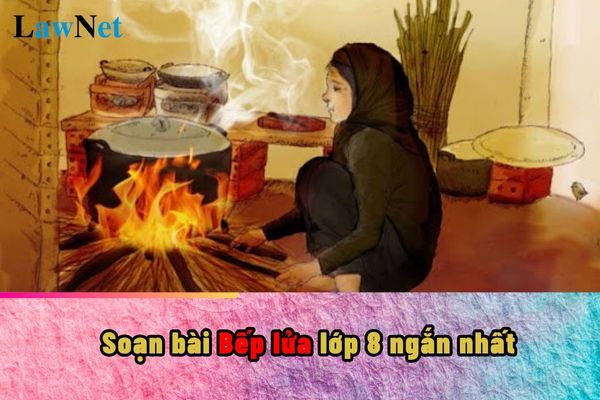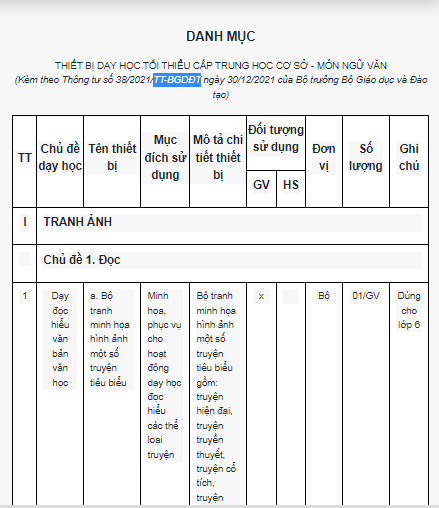What are guidelines on preparing the lesson "Bếp lửa" for grade 8 students in Vietnam? What are requirements for the reading section in the grade 8 Literature curriculum in Vietnam?
What are guidelines on preparing the lesson "Bếp lửa" for grade 8 students in Vietnam?
"Bếp lửa" is part of the curriculum for grade 8 students in the Literature subject.
Students can refer to the following guidelines on preparing the lesson "Bếp lửa":
|
Guidelines on preparing the lesson "Bếp lửa" Analysis of the Poem "Bếp lửa" by Bang Viet |
*Note: Information is for reference only./.

What are guidelines on preparing the lesson "Bếp lửa" for grade 8 students in Vietnam? What are requirements for the reading section in the grade 8 Literature curriculum in Vietnam? (Image from the Internet)
What are requirements for the reading section in the grade 8 Literature curriculum in Vietnam?
Based on the regulations in the General Education Program issued with Circular 32/2018/TT-BGDDT, the requirements for the Grade 8 Literature reading content are as follows:
Literature Text
Comprehension of Content
- State the general content of the text; identify representative details, themes, stories, characters within the integrative context of the work.
- Recognize and analyze the theme, ideology, and messages the text intends to convey to the reader through its artistic form; analyze some bases for determining the theme.
- Recognize and analyze the feelings, emotions, main inspiration of the writer expressed through the text.
Comprehension of Form
- Recognize and analyze the role of imagination in receiving literature texts.
- Identify some elements of comedic stories and historical stories such as plot, setting, characters, language.
- Recognize and analyze single-line plots and multi-line plots.
- Recognize and analyze the effects of some main artistic techniques of satirical poetry.
- Identify some poetic law elements in classical Chinese poetry such as structure, coherence, law, rhyme, rhythm, and parallelism.
- Recognize and analyze the uniqueness of a poem expressed through language, imagery, structure, emotional flow.
- Identify and analyze some elements of comedy such as conflict, action, character, dialogue, satirical technique.
Contact, Compare, Connect
- Understand that each reader may have a unique way of receiving a literature text; respect and learn from others' ways of reception.
- Comment on the content reflected and perspectives on life and people of the author in the literature text.
- State changes in thoughts, feelings, or lifestyle of oneself after reading literature works.
Extensive Reading
- During a school year, read at least 35 literature texts (including those guided for reading online) equivalent in genre and length to the texts studied.
- Memorize some favorite poems or excerpts from the program.
Argumentative Text
Comprehension of Content
- Identify the thesis, arguments, reasoning, and representative evidence in the text.
- Analyze the relationship between the thesis, arguments, reasoning, and evidence; the role of arguments, reasoning, and evidence in expressing the thesis.
Comprehension of Form
- Distinguish between objective reasoning, verifiable evidence, and the writer's subjective opinions and evaluations.
Contact, Compare, Connect
- Relate the content mentioned in the text to contemporary social issues.
Extensive Reading
- During a school year, read at least 9 argumentative texts (including those guided for reading online) equivalent in length to the texts studied.
Informational Text
Comprehension of Content
- Analyze the basic information of the text.
- Analyze the role of details in expressing the basic information of the text.
Comprehension of Form
- Recognize and analyze characteristics of some types of informational text: text explaining a natural phenomenon; text introducing a book or film seen; identify the relationship between text characteristics and its purpose.
- Recognize and analyze how information is presented in the text, such as by chronological order, cause-effect relationship, level of importance of the subject, or by comparison and contrast.
Contact, Compare, Connect
- Relate information in the text to contemporary social issues.
- Evaluate the expression effectiveness of a non-verbal means in a specific text.
Extensive Reading
- During a school year, read at least 18 informational texts (including those guided for reading online) equivalent in text type and length to the texts studied.
What is minimum teaching equipment for Literature in lower secondary schools in Vietnam?
Based on the Minimum Teaching Equipment List for Lower Secondary Schools - Literature subject issued with Circular 38/2021/TT-BGDDT, the detailed list is as follows:

>>> See the full list of minimum teaching equipment for Literature in lower secondary schools in Vietnam Here.

